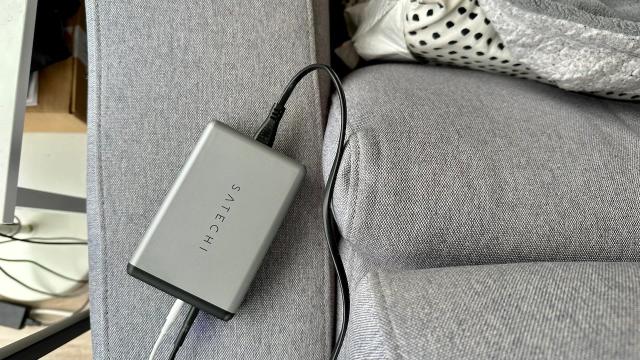For the last few years, GaN charging has been one of those things that über nerds and business travellers have been raving about. But, when the time comes to buy a charger, most people don’t realise why it’s worth the premium over traditional chargers and miss out on the better product.
So, here’s your guide to what gallium nitride is, why it’s not a Doctor Who character, why it’s better than silicon, and which chargers you should look for when you’re at the shops.
What is the GaN in GaN charging?
Gallium nitride sounds like a fantasy villain, or maybe something you’d sniff before going into a bathhouse, but actually, it’s a combination of gallium (atomic number 31, Ga, if you remember your periodic table of elements) and nitrogen (atomic number 7, N). GaN has been in common use since the early 90s, mostly in blue LEDs. It’s also the material that was used for the blue light that reads Blu-rays. Now it’s used as the semiconductor material in high-wattage chargers.
Why is GaN better than Silicon?
GaN has a bandgap that’s three times wider than silicon. The bandgap is the range where no electrons can exist, which basically allows it to conduct energy more efficiently.
To break that down a bit, you know how your old Silicon laptop charger used to get so warm you could use it as a heat pack? That’s because laptop chargers were really testing the limits of how much electricity silicon could comfortably transfer, so it’s losing a lot of that energy as heat.
Because of that wide bandgap, GaN can conduct more power in a smaller space, using fewer materials, and wasting less energy on heat. This means GaN chargers are smaller, use less electricity, can charge more devices at the same time, and, because they don’t overheat, they should notionally last a lot longer than tradition silicon chargers.
Then why isn’t everyone rushing out and buying GaN chargers right now?
Because they’re expensive. GaN chargers are better than silicon in every single way but one: They’re generally $15-$30 more expensive than their larger, less efficient counterparts.
This is because it’s a newer technology, so factories are having to spend more on tools to make GaN chargers, whereas they’ve already perfected silicon chargers as much as they can.
In the long run, GaN chargers often work out to be cheaper, given their longer life span, ability to charge more devices, and lower electricity wastage. But we live in a time where grocery prices are going up exponentially, and the Reserve Bank has decided that the only way to deal with that is to make housing borderline unaffordable, so it’s totally understandable that some people won’t want to pony up the extra upfront.
Michael Broadhurst, head of marketing at Cygnett suggests that there’s a border between where it comes more worth it to go GaN over silicon.
“It’s important to note the advantages of GaN come at a cost to the consumer and are more beneficial if you require a wall charger capable of delivering 60W or higher. The premium price on GaN may be harder to justify purchasing 20W – 60W wall chargers because silicon wall chargers still deliver many compelling benefits to consumers. These benefits include a fast-charging experience delivered in a compact form factor (not as compact as GaN but still very compact), at a more affordable price. Whilst GaN is exciting technology, silicon wall chargers are not broken,” he told Gizmodo Australia.
Which are the best GaN chargers?

Personally, I travel a lot for work, and couldn’t live without my Satechi chargers. The main one I rely on is the 100W USB-C PD Compact GaN Charger, because it’s got two USB-C ports and one USB-A, so I can charge my phone and watch overnight, as well as my MacBook Air. I really like that it has a long power cable because it means I can keep the charger on the bedside table and I’m less likely to forget it/I don’t have to keep climbing behind the weird stuff hotels keep putting in front of the powerpoints every time I want to change cables. When I travel now, I still bring 2-3 battery packs and 2-5 pairs of headphones, but only one charger.
At home by the couch, I use the Satechi 108W Pro USB-C PD Desktop Charger for its two USB-C and two USB-A ports to charge our devices while we watch TV.
For people who have just lost their laptop charger and are looking for an easy replacement that’ll also charge extra stuff, I strongly recommend the Mophie Speedport 120W 4 Port GaN Fast Charger. It’s got two 100W USB-C ports, one 20W USB-C port (for your phone) and a USB-A port, so it’ll have you covered for almost anything you need to charge, while still having a power cord with a decent length. This is the one that I really like having in my home office because it has almost every charging need covered while only using one power point (and not spreading to block everything else on the power board, unlike some other laptop chargers).
If you’re looking for a budget GaN charger and don’t need too much juice, the Cygnett 70W Dual Port GaN Wall Charger lets you charge two devices simultaneously for under $80.
